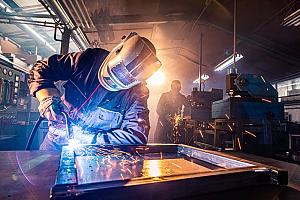Editor-in-Chief
- FMA
- The Fabricator
- FABTECH
- Canadian Metalworking
Categories
- Additive Manufacturing
- Aluminum Welding
- Arc Welding
- Assembly and Joining
- Automation and Robotics
- Bending and Forming
- Consumables
- Cutting and Weld Prep
- Electric Vehicles
- En Español
- Finishing
- Hydroforming
- Laser Cutting
- Laser Welding
- Machining
- Manufacturing Software
- Materials Handling
- Metals/Materials
- Oxyfuel Cutting
- Plasma Cutting
- Power Tools
- Punching and Other Holemaking
- Roll Forming
- Safety
- Sawing
- Shearing
- Shop Management
- Testing and Measuring
- Tube and Pipe Fabrication
- Tube and Pipe Production
- Waterjet Cutting
Industry Directory
Webcasts
Podcasts
FAB 40
Advertise
Subscribe
Account Login
Search
Automating spot welding to win fabrication work, maintain culture
Michigan-based Lewis Welding finds a new level of production efficiency with cobot
- By Dan Davis
- Updated July 3, 2024
- July 3, 2024
- Article
- Automation and Robotics

Lewis Welding technician Jorge Dorantes Vasquez fixtures the next part to be welded while the Pro Spot cobot spot welding system welds another part. Images: Pro Spot Automation
It’s not the riddle of the Sphinx, but it’s a riddle that many a metal fabricator has wrestled with over time: How do you expand while still maintaining the company culture that allowed the shop to be successful enough to grow?
Lewis Welding, Wyoming, Mich., pondered that very question as it looked at potentially winning several jobs involving the fabrication of water heater parts, more specifically airflow systems that help the appliances to maintain consistent water temperatures. If the company were to win that work, it could be looking to add as many as seven people to meet the volume requirements associated with the new contracts. That’s quite the change for a company that has about 40 employees currently.
“We want to keep the same culture, where everybody knows everybody else and where they feel comfortable enough to ask Tim [Mendes, Lewis Welding president] any questions they might have,” said Jake Buchholz, an estimator and operations manager for the shop. “That’s the thought process that we have right now.”
Buchholz has been with Lewis Welding just under two years, but he’s been in the metal fabrication and finishing business in western Michigan for about 27 years. At a prior stop at a much larger metal fabricating company, he had witnessed the use of collaborative robots to do things like forming at a press brake or hardware insertion. He thought the same approach could work with spot welding the water heater parts, but he had not really seen a collaborative robot application like that. A website search, however, soon provided him with the automation answer for which he was looking.
Meet the Cobot That Spot Welds
Pro Spot Automation is the maker of the i5s automated spot welding platform that makes use of a Universal Robots collaborative robot, or cobot. Pro Spot International, the parent company, is well known in the collision repair market, where its spot welding technology is widely used.
At Automate 2023, an annual robotics and automation trade show, Bob Hamilton, Pro Spot Automation’s chief technology officer, said typical spot welding equipment was too heavy to have a cobot carry it and maneuver as needed. But two years of research and development led to a reconfiguration of internal parts and the incorporation of new materials, making the transgun, a transformer and gun designed together for the spot welding application, and a spot welding arm light enough for the cobot to move easily with both attached.
Upon discovering the spot welding cobot, Buchholz said that he knew it was the right fit for the water heater part application. Not only could the cobot do the welding job efficiently and consistently, it also could safely work around humans, eliminating the need to erect guarding around the cell. (Cobots are smaller and lighter than traditional industrial robots, and they work at speeds that produce very little momentum, which greatly reduces the injury risk as they work in the presence of humans.)
“Between the safety and agility of the cobots, there’s minimal risk,” Buchholz said. “If this job were to go away, we can pull the robot off and use it to do something else.”
For the moment, however, the i5s Smart Spot welding cobot is doing the job it was purchased for, and the results have proven to be noteworthy.
Automation Makes an Impact
Lewis Welding has the cobot set up in an open spot in its new 120,000-sq.-ft. facility. Two fixture tables that accommodate the 4-ft.-long parts are placed at 45-degree angles in front of the cobot. With this configuration, an operator can load the parts and clamp them in as the cobot spot-welds the other part. Altogether, Buchholz estimated the cell to be about 12 by 10 ft.
“If we needed to move it, we can move it. That’s nice,” he said.
Programming for the spot welding cobot system is designed to be user-friendly. Hamilton said the spot welding system’s control software is integrated with the cobot controller, so the operator doesn’t need to worry about learning two separate control interfaces. The i5s also has a feature called Auto Weld, which takes operator estimations out of the programming process. The equipment is able to sense material thickness and adjust the weld power accordingly for the job.
“Our weld supervisor was a little nervous when we first got this. He’s never seen anything like this,” Buchholz recalled. “But within a couple of hours, he was like ‘I got this.’”
Lewis Welding is only running one job with the cobot right now, but adding jobs shouldn’t be too difficult. The spot welding system has a built-in library for materials, weld caps, and thickness stackups.
Because Pro Spot has experience in the collision repair industry, where repair documentation is an absolute necessity when dealing with insurance firms, the company brought the same capabilities to the i5s. The system provides a synchronized log of welding activity (weld position, weld schedule, and power usage) that can be exported to e-mail via Wi-Fi. Such data collection might prove attractive to shops that have customers that require thorough traceability and process control.
Buchholz said that the cobot spot welding system is producing about 140 parts per shift, when previously one operator at a spot welding machine produced 100 parts per shift. An added benefit, he said, is that the operator ator doesn’t have to manipulate the large parts over the course of an entire shift.
“It’s a little easier on his body. He’s not leaning over the process the entire time,” Buchholz said.
If the other high-volume jobs come through, Lewis Welding could be looking to add three or four other similar cobot welding systems. They have proven to deliver reliable and consistent spot welds, allowing the shop to continue to grow and maintain the same successful working environment.
With more automation comes more responsibility, however. That’s led Buchholz to wonder if it makes sense to add an automation engineer—somebody with experience in setting up and connecting cells with cobots and other machinery, such as a press brake. That’s more overhead for a lean metal fabricating enterprise, but it does create a scenario where more shop floor efficiencies might be discovered down the line.
Lewis Welding isn’t alone in exploring this potential hiring scenario. Plenty of shops are having similar conversations given what cobots bring to the table.
About the Author

Dan Davis
2135 Point Blvd.
Elgin, IL 60123
815-227-8281
Dan Davis is editor-in-chief of The Fabricator, the industry's most widely circulated metal fabricating magazine, and its sister publications, The Tube & Pipe Journal and The Welder. He has been with the publications since April 2002.
subscribe now

The Fabricator is North America's leading magazine for the metal forming and fabricating industry. The magazine delivers the news, technical articles, and case histories that enable fabricators to do their jobs more efficiently. The Fabricator has served the industry since 1970.
start your free subscription- Stay connected from anywhere

Easily access valuable industry resources now with full access to the digital edition of The Fabricator.

Easily access valuable industry resources now with full access to the digital edition of The Welder.

Easily access valuable industry resources now with full access to the digital edition of The Tube and Pipe Journal.
- Podcasting
- Podcast:
- The Fabricator Podcast
- Published:
- 07/02/2024
- Running Time:
- 66:34
Desirée Guzmán, a welding instructor with Chicago Women in Trades (CWIT), joins us to talk about her full-circle...
- Trending Articles
Launching a career in metal fabrication and the skilled trades

Customer service a key for both traditional, e-commerce fab businesses

Automating spot welding to win fabrication work, maintain culture

The Why, What, and How of Precision Sheet Metal Automation

Feintool expands in Tennessee

- Industry Events
Precision Press Brake Certificate Course
- July 31 - August 1, 2024
- Elgin,
Laser Welding Certificate Course
- August 6 - 8, 2024
- Farmington Hills, IL
Golf 4 Manufacturing
- August 19, 2024
- Waukegan,
The Fabricator's Technology Summit
- August 20 - 21, 2024
- Eglin, IL



























